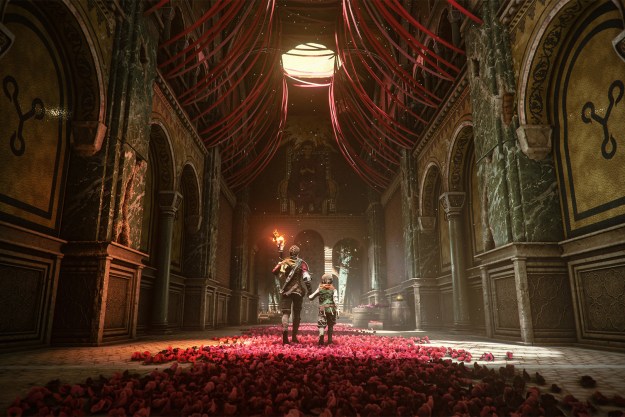A Plague Tale: Requiem review: gorgeous sequel has growing pains
 A Plague Tale: RequiemMSRP £59.99
A Plague Tale: RequiemMSRP £59.99
“A Plague Tale: Requiem improves on its predecessor with gorgeous visuals and more varied gameplay, but it struggles to balance its increased action and morally nuanced storytelling.”
- Moving story beats
- More varied gameplay
- Better item crafting
- Astounding visuals
- Clumsy moral commentary
- Weak action scenes
There’s a specific sequence in A Plague Tale: Requiem that captivated me … and then lost me just as quickly. Returning protagonist Amicia and a new companion are trying to carefully sneak through an area packed with guards (a familiar scene in its predecessor, A Plague Tale: Innocence). As Amicia, I start quietly killing guards by beaning them with rocks and extinguishing their torches to send rats after them.
New to Amicia’s way of doing business, my partner asks why she keeps killing these guys instead of just sneaking around them. Amicia keeps making excuses, ones that perfectly mirror my own twisted logic. “Oh, they were going to get in the way, and they’re bad guys anyways.” It’s an effective moment of introspection in a game that’s built around giving players the option to be the pacifist in situations. Shortly after, I’m thrown into the stealth game’s silliest sequence.
Amicia is backed into a room and trapped, when guards start pouring in. I have no choice but to kill waves of them with my sling as Amicia gives in to her bloodthirst, locked in a violent mental breakdown as her partner begs her to stop. It’s an over-the-top moment where the game is forced to momentarily reckon with its violence – it’s almost embarrassed of itself, apologizing for all its gleeful killing.
And yet, not but an hour later, I’m back at it as if nothing happened, killing guards with some fun new tools and unlocking new skills as a reward for doing so. A Plague Tale: Requiem is a fantastic sequel on several counts. It improves on its predecessor in just about every way by finely tuning its stealth and navigation systems, adding more gameplay variety, and delivering a visually stunning world that puts games with much larger budgets to shame.
Its weak spot comes down to its messy storytelling, which exposes the thematic limits of a medium that’s over reliant on violence as its primary form of interaction.
Meditations on murder
A Plague Tale: Requiem is a bigger version of Innocence in every way, from pumping up its stealth formula to supersizing its length (the sequel is about twice as long as the first game). That’s reflected in the narrative too, which goes for a larger-scale story complete with some globe-trotting. Requiem continues the 14th century tale of Amicia and her little brother, Hugo, who’s afflicted with a sort of supernatural disease called the Prima Macula. Amicia is determined to find a cure, though her world is still in the throes of the Black Plague as thousands of deadly rats have taken over Europe.
Like the original, there are moments of the story that shine. Requiem is at its best when it’s reflecting on how the young Hugo is being poisoned by the world around him. He’s a sponge absorbing an incalculable amount of death amid other cruelties of the 14th century. In one heart-wrenching scene, Hugo learns about the practice of slavery.
Initially distraught over the concept, he falls further into despair when he finds a stuffed toy left behind by a child slave. He’s gutted by the idea that even children could be slaves, and even more ruined by the fact that their captors wouldn’t even let them keep their toy. It’s a brutal moment, one of many that hacks away at any hope for humanity the innocent boy has left.

While those scenes are moving, building on the game’s ultimate thesis about the struggles of protecting children from the horrors of the real world, the message is muddied by its more overbearing meditations on violence.
Like a lot of video games, this is one whose main systems revolve around killing, and its creators struggle to reckon with that. The story routinely pauses to have Amicia question all the violence she’s committing. Is it ever justified?
Is she as bad as the rats that mindlessly devour everything in sight? And what kind of example is she setting for her impressionable younger brother? These would be compelling questions if the territory hadn’t been tread to death by now.
As games become more narratively ambitious, but refuse to give up murder as a primary hook, they have no choice but to slide in some commentary about the ethics of what players are doing. The Last of Us did it successfully, while Part 2 struggled to fully bring home its point about cyclical violence at the same time that it encouraged players to jump into a New Game+ mode with all their upgraded guns. Then there’s Ghost of Tsushima, which spins its stealth samurai combat into a moral quandary about honor. It’s a clumsy attempt that fails to have its cake and eat it too.
A Plague Tale: Requiem goes a similar route, trying to elevate its action with thematic intent. However, it’s a clumsy attempt that fails to have its cake and eat it too. For instance, Requiem actively encourages players to kill enemies rather than sneak around them.
It features a skill tree that automatically unlocks new abilities depending on your playstyle. Choosing to kill enemies unlocks various skills that’ll make Amicia deadlier. But even when trying to stick to a nonlethal playstyle (which isn’t fully possible), the stealth skill tree culminates in an ability that’ll let Amicia more easily stab armored enemies.
The self-conscious moral waxing isn’t enough to completely spoil an otherwise compelling, though at times overstuffed, story, but it’s a hollow and distracting attempt to justify its emphasis on creative killing. If developers continually feel the need to soften their action with self-reflective commentary on violence, perhaps it’s time for those studios to explore new ways to play — ones that better reflect the stories they want to tell.
Improving on the original
Though its narrative struggles to align with its gameplay, Requiem solidifies Asobo Studio as one of the finest stealth developers around today. Like A Plague Tale: Innocence, making it through a chapter here requires a combination of careful sneaking, puzzle-like navigation, and a touch of alchemy.
Each of those elements has been expanded in Requiem, making it feel like there’s no golden path through any given stealth section. For instance, I’m given way more choices when faced with a guard this time around. Like the previous game, I have the option to sneak around one quietly, kill him by launching a rock at his head with my sling, or turn stray rats against him by using crafting resources that’ll extinguish flames, which act as safe zones from the light-sensitive creatures.
Amicia has a few more recipes at her disposal though, as she can use tar to create a flammable zone or augment shots with an odor that’ll lure rats. So when trying to clear out two guards at once, I could launch a pot of tar at them and follow up with an ignifer slingshot that lights them up. Alternately, I could launch a pot of extinguis at them, putting out both their torches and the vampire they’re standing around, serving the rats a feast.
Or perhaps I could leave them alone entirely, sneaking through an adjacent building instead and simply tossing a rock to cause a sound distraction. Requiem‘s strength as a sequel largely comes down to its added variety. Each tool can be augmented with every alchemy type via a more streamlined weapon wheel, and that’s a little change that goes a long way.
It’s much easier to select a tool, quickly cycle over to an ammo type, craft a few shots, and let it rip, allowing me to be much more reactive if something goes wrong. With the option to pour any mixture into a pot that can cause an area effect, I’m able to think a little bigger and more creatively as I tackle a section. That positively impacts the basic navigation too.
Specific sections of the game force Amicia to make her way through an area full of rats by using her tools to distract them and create fiery safe zones. This time, it feels less like there’s one solution to each puzzle. I can use tar to expand a flame’s range, throw a pot of ignifer to temporarily scare off rats, or launch a smelly arrow into wood to draw the rodents’ attention.
If I get swarmed, I can use a pyrite whip as a last-ditch effort to fight the herd back for a few seconds. There are more decisions to be made in any given section, loosening any restrictions present in the first game.

Requiem‘s strength as a sequel largely comes down to its added variety. Rather than showing its full hand upfront, it’s always introducing new tools, alchemy recipes, and AI companions that bring a special twist every few chapters.
In one section, I’m traveling with a knight who I can sic on guards like an attack dog. In another, I’m with a partner who can use a crystal to reflect a flame’s light and create a moving safe zone. Each idea brings a momentary twist to the established formula that deepens its potential for puzzles.
The only slipup comes when Requiem tries to lean into action. Several scenes throw Amicia into battles where she has to take down waves of guards. Considering that her arsenal is simply a rock that has to be wound up before throwing and a crossbow that can only hold a few shots at once, these busier encounters stretch the limits of tools meant to be used in a methodical fashion.
Amicia also dies in one or two hits, which works in a stealth setting, but becomes immensely frustrating when trying to fight enemies in small arenas while archers with magnetic aim fire from behind. Several of these encounters left me with dozens of death screens. The combat issue is interlinked with Requiem‘s narrative woes.
In trying to pump up the scope with more straight action, Requiem creates problems for itself. Systems originally built for stealth aren’t a neat fit for faster action set pieces, and characters spend several of these scenes trying to contextualize the violence in a forced manner. Requiem feels more comfortable when it’s not trying to follow in The Last of Us‘ footsteps.
Truly gorgeous
Though parts of the sequel struggle to keep up with an increased scope, that’s certainly not a problem on the technical side. Requiem is one of the best-looking games I’ve played in this still-new console generation, punching well above its weight class.
With Amicia and Hugo departing their plague-infested hometown, Asobo Studio gets more opportunities to paint colorful European landscapes full of vibrant greenery and bright flowers. That creates a more striking juxtaposition any time players are tossed into a rundown village that’s been ravaged by rats. It makes for some of the most jaw-dropping imagery I’ve ever seen in a game.
Later moments lean into sublimely supernatural imagery, allowing the artists to build more otherworldly spaces. Every moment — both the beautiful and horrific — are rendered with an astonishing amount of detail that I’d expect from a heavily-funded Sony exclusive, not a sequel to a modest game that bordered on “eurojank” territory. Requiem‘s most impressive (and grotesque) magic trick comes from its literal tidal wave of rats.
Upping the series’ ante in the wildest way possible, rodents don’t just passively hang around in swarms this time. More cinematic sequences find Amicia sprinting away from tens of thousands of rats as they swallow entire towns behind her like a monsoon. It makes for some of the most jaw-dropping imagery I’ve ever seen in a game, pushing the limits of modern tech to create the kind of spectacular imagery that can make video games such a special medium.

A Plague Tale: Requiem deals with the complexities of growing up, and that theme is ironically baked into the game itself.
It learns from its predecessors’ mistakes to create a gorgeous adventure with more confidence and personality. However, that growth spurt presents some awkward challenges, as the sequel struggles to balance its own identity with what’s expected from a more mature game in today’s landscape. Chalk it up to some adolescent growing pains — we’ve all been there.
A Plague Tale: Requiem was reviewed on an Xbox Series X hooked up to a TCL 6-Series R635.
Editors’ Recommendations





